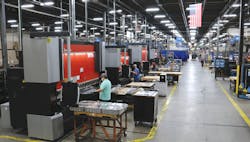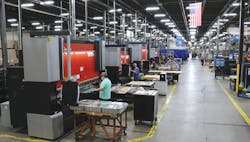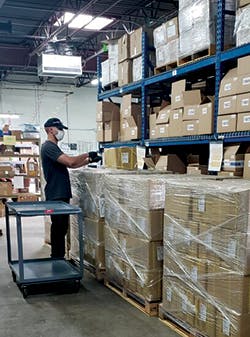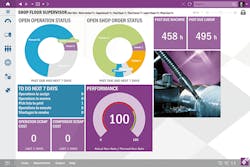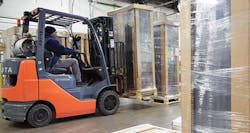When several manufacturers and a developer of manufacturing software were asked: What methods and tools are you using to mitigate risk in your supply chain? How do you anticipate and minimize problems? What is your inventory strategy? The answer was reliable, honest communication between manufacturers and suppliers combined with granular data.
“You must communicate key data and be clear about commitments and expectations,” emphasized Steve Tokarz, president of IMS Manufacturing.
“Within the supply chain, there must be a communication chain,” agreed Thomaie Hilaris-Neris, president and integrator at Ergoseal, a manufacturer of mechanical, lip, non-contacting, and magnetic seals for OEMs. “We talk with our partners to get aligned.”
“We practice a team approach with our customers and suppliers. We see the process as people-to-people at the end of the day,” added Hilaris-Neris.
“We’ve noticed a higher value or need for collaboration and trust for suppliers to be forthcoming and manage expectations,” says Kevin Miller, associate vice president of Pre-Sale Solutions for IFS, a developer of FSM, ERP, and EAM solutions for manufacturers midmarket and higher. “IFS works with our manufacturing customers to learn their requirements and build desired features in their software.”
“Overall, this is an unprecedented time,” says Hilaris-Neris of Ergoseal. “All our partners understand this.”
“We see from our customers and their suppliers, that there is the pressure of all kinds to accommodate,” says Miller of IFS.
Inventory planning
Perhaps the biggest change in the supply chain is inventory planning. “Safety stock” and “risk buying” have pushed aside JIT (Just In Time) inventory.
“Our customers’ minimum inventory has now doubled compared to before 2020,” says Miller. The IFS software helps manufacturers calibrate inventory by targeting what products have high volume sales along with high profit.
“We now are approved by our customers to purchase raw materials and components ahead of time. We “risk buy” hard-to-source metals, copper as well as electronic components. Our customers give us coverage,” clarifies Tokarz. “IMS Manufacturing customers have moved to orders with six-month and longer lead times.”
Consistent with their team approach, Ergoseal’s key customers and suppliers agreed to keep higher inventories and reorder with longer lead times.
Demand planning and forecasting
Again, it is a must to plan with your suppliers and customers. Both in conversation and data sharing manufacturers are gathering more information from their customers to provide to vendors.
“At IFS we’ve noticed an uptick in interest post-2020,” Miller asserts, “in on-demand planning and forecast from our manufacturer customers.”
“Our software is modular,” continues Miller. “We use examples to help companies design and customize dashboards to what is important to their business. We house a lot of data, but it may not be data that is useful. Our dashboards are tailored to the role in the company.”
Further, the complexity of the entire chain must be visible. “Our software houses data worldwide such as industry trends and weather data that augments the forecasting,” explains Miller. “For example, the system can identify and alert a manufacturer or supplier to a potential shipping delay. It zeros in on minimum quantities and the due dates, the availability of a component or raw material, and current expectations for delivery. It identifies possible pitfalls and delays and triggers automatic reach-outs to suppliers.
The IFS software does identify “outliers,” such as exceptionally high quantities, which is excluded from the trend data.
Tokarz says IMS Manufacturing uses Epicor ERP to automate the process. “With key dates input in the system, automatic emails go to thousands of vendors with the question: On time? The purchasing department will follow up on all the negative replies.”
“We use our Global Shop Solutions ERP dashboard that shows reorder points, contacts with customers, and suppliers. We also have preventative conversations to stay on track well in advance of when materials or components are due, says Hilaris-Neris of Ergoseal. “Our sales team now has quarterly meetings with customers to forecast business needs.”
“The spot market is where all the planning can fall apart,” says Tokarz. “You are competing with everyone. One strategy is to lock in pricing. For example, we locked in some of our raw material for the year ahead.”
To address this and all challenges in the supply chain, you need primary and secondary suppliers, and beyond, particularly for key components. The data available can help plan those alternatives.
“Our customers can look at their dashboard for suppliers and identify the materials available and the lead time,” describes Miller of IFS. “For example, let’s say I need a part. I can get the part from four suppliers. They will see the lead time and the price. With a six-weeks lead time, the price will be lower, but with two weeks lead time, the price will be higher.
We can also send out a request for a quote to suppliers and rank in a matrix,” Miller adds.
“We work our logistics to obtain quotes for shipping compared to small air freight and share the cost burden with the customer,” says Hilaris-Neris of Ergoseal. “We also currently order more components domestically.”
“We’ve noticed an increase in sourcing domestically,” agrees Miller of IFS. “To some extent, this is due to shipping issues. We see that companies are prepared for alternatives and eager for new methods.”
Supplier measurement and feedback
Use your scorecards for better communication with your vendors. Whether you are doing quarterly or monthly scorecards, depends on your business needs or the size of your business. Use those scorecards to have meaningful conversations with your vendors.
“At Ergoseal we use our ERP system to do weekly scorecards for use by purchasing,” says Hilaris-Neris. “Suppliers are scored by categories: Communication, how they work with us, on-time delivery, and quality. Our suppliers then move toward growth. If a supplier gets a negative score, they are always receptive to improvement.”
“We do a monthly scorecard with 33 measurements for suppliers’ cost, quality, and delivery,” adds Tokarz of IMS Manufacturing. “Our vendors are good partners and we are able to weed out the vendors who are not.”
This story originally appeared in the August 2021 issue of Plant Services. Subscribe to Plant Services here.
Deanna Nord, owner of Nord Strategy Group, is a writer, public speaker, and creative strategist. Contact her at [email protected].
